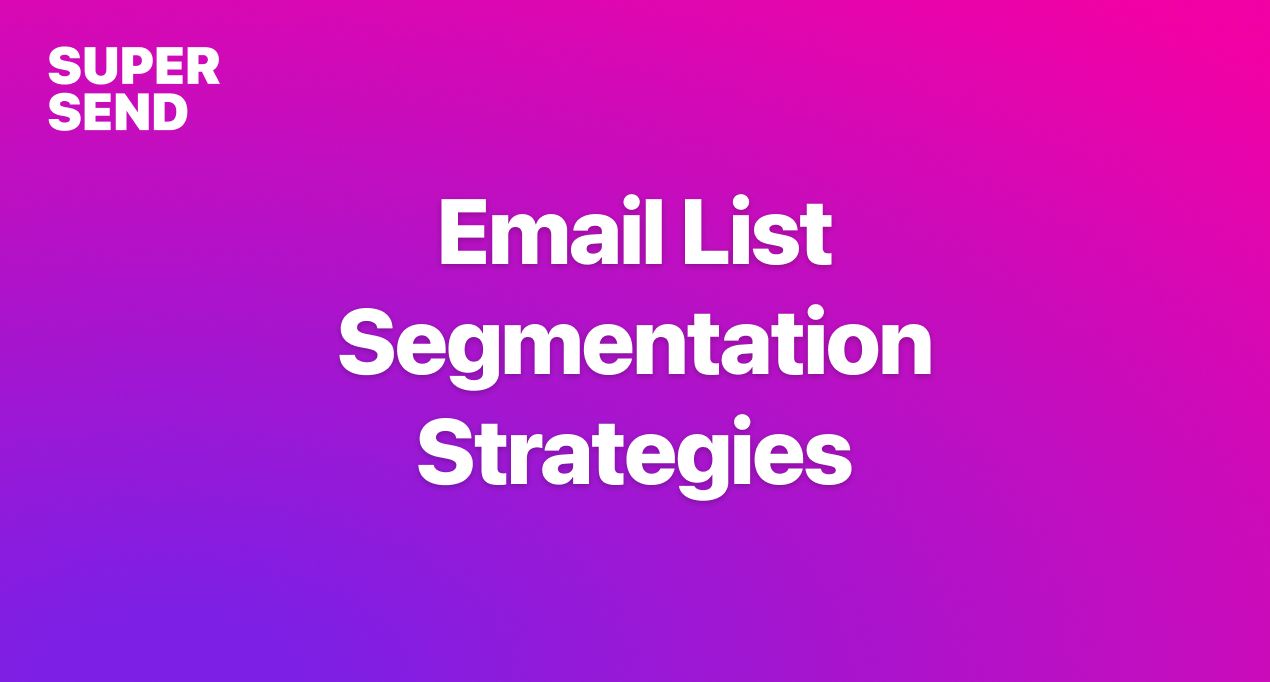Guide to Email List Segmentation [7 Key Strategies]

Email Segmentation is about splitting your list into tailored groups based on a specific parameter for a more relevant messaging.
Tailored emails lead to a whopping 760% revenue increase, as found by a DMA report.
We curated 13 key levers that can be good starting points for anyone considering experimenting with a segmented list. We'll talk about 7 of these at length later in the blog:
Demographic Segmentation: Know your audience - their age, gender, income, etc. This helps tailor messages that hit home.
Geographic Segmentation: Location matters. Customize content based on where your subscribers live.
Behavioral Segmentation: Watch how subscribers interact with your site and emails. This gives clues on what offers they might like.
Engagement Level: Group subscribers by their activity level. Approach the less active differently to win them back.
Customer Lifecycle Stage: Depending on where they are in their journey, from new leads to loyal fans, tailor your content accordingly.
Past Purchases: Suggest related products or newer versions based on what they've bought before.
Email Preferences: Let people choose what they want to hear about. This makes segmentation easier.
Lead Magnet Type: Segment according to the free resources people signed up for. It shows their interests.
Shopping Cart Abandonment: Nudge those who left items in their cart. A little push might just complete the sale.
VIP Customers: Treat your best customers with special offers or previews. They deserve it.
Subscription Date: Customize messages based on how long someone's been with you. It keeps content fresh.
Survey Responses: Use survey insights to group your audience. It's direct feedback on their preferences.
What Is Email Segmentation?
It's a strategy that lets you send more personal emails. Why? Because personal emails get better engagement. Think of it as connecting the dots between what your subscribers like and the emails you send them. Spot on content increases opens, clicks, and sales.
Benefits of Email Segmentation
Segmented emails mean you're sending just what your subscribers are interested in. No more guessing. This relevance boosts your open and click-through rates, not to mention it keeps your audience from feeling overwhelmed by irrelevant content. With proper segmentation, your email campaigns hit the mark every time, driving up engagement and conversions.
How to Segment Your Email List
- Demographics: Use what you know about your subscribers' backgrounds to send spot-on messages.
- Behavioral Data: Past actions give clues for future campaigns. Tailor your emails to fit these habits.
- Email Segmentation Tools and Software: Pick tools that mesh with your systems and make segmentation easy. Good software takes the guesswork out of who gets what message.
Email Segmentation Strategies
- New Subscribers & Welcome Offers: Start off strong with a warm introduction and a special deal.
- Engaged vs. Unengaged: Keep the engaged interested and work on bringing the unengaged back into the fold.
- Past Purchasers: Offer deals on complementary or related products.
- Seasonal Campaigns: Use holidays and events to send timely, appealing content.
- VIP Customers: Roll out the red carpet with exclusive offers.
- Abandoned Cart Reminders: Gently remind customers about what they've left behind.
- Geo-targeting: Location can play a huge role in making your emails feel highly personalized.
Summary
Email segmentation is an absolute non-negotiable for effective marketing in 2024. By understanding and applying these strategies, you're not just sending emails; you're sending the right emails to the right people at the right time. It's a way to boost your engagement and conversions, making your email marketing efforts worthwhile.
FAQs
Why segment your email list?
- It allows for a more precise and relevant communication, further enhances engagement and conversions.
Can behavior influence segmentation?
- 100%. Segmenting by actions like past purchases boosts personalization and trust.
What tools help with email segmentation?
- Look for email platforms and CRMs designed for segmentation. Once you have a segmented list, use a platform like Super Send to run highly personalised cold outreach campaigns across Email, LinkedIn or twitter.
How often should you segment your list?
- Regular updates keep your segments fresh and relevant.
Pro tip: Make sure to verify your email lists at regular intervals to ensure your bounce rates remain in check. Use a tool like Super Send's Email Verifier to do the same.

Is segmentation good for small businesses?
- Yes, businesses of any size can see significant benefit from a well-segmented email list.

